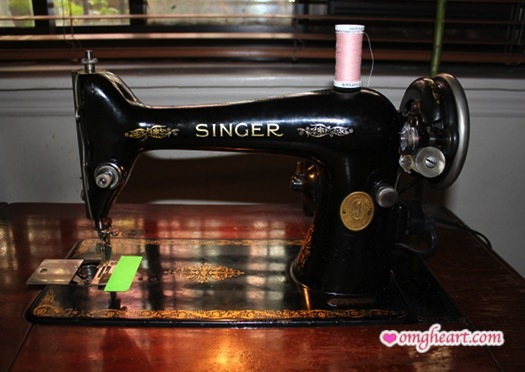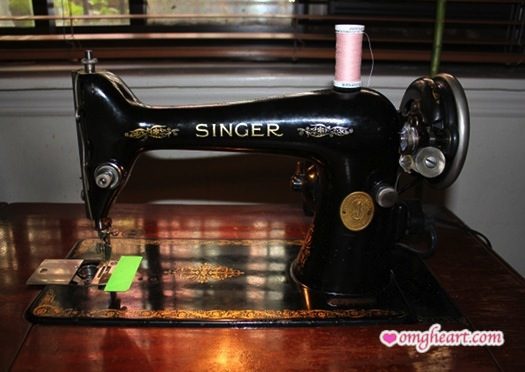
Singer Treadle, “AB Series”, Model No. 66. Made in Elizabeth, NJ, USA. circa 1927.
This is what started it all! Late last summer I wandered into a junk sale at the Moravian Church down the street and spotted this lovely sewing machine for $25. I had been considering sewing for awhile but didn’t know where to begin. I checked into a few things like classes and sewing machines just to get an idea of what it would take to get started. But I still hadn’t arrived at a suitable entree into it yet. Until I spotted this vintage Singer. It was in perfect working order, complete with sewing table and knee pedal, and all in excellent condition. After considering its vintage novelty and the fact that it was $25, I figured I would snap it up now to start.
It’s a treadle-style sewing machine from the 1920’s. In cast iron black enamel with gold filigree detail and engraving and most all of its original parts! Even the motor and light are original. It only does a single straight stitch in various lengths. It came in a lovely sewing table with a knee-operated pedal instead of the traditional foot pedal. I’m told attachments can be added to expand the stitch selection. Something I’ll have to check into further. At $25 it was still a luxury for me though and I still hadn’t found a suitable way for me to begin learning. But worth it.
Note
Although it’s the stylish little sewing machine that keeps on trucking, these vintage sewing machines have a few drawbacks. Since it only does a single style of stitch – Straight Stitch, sewing on this type of machine requires different sewing techniques. The most basic of stitches any sewer needs include – Straight Stitch, Zigzag Stitch, and Back Stitch. Not having the last 2 stitches requires a few modifications in your sewing technique. Mainly, the addition of Pinking Shears to seal raw edges and learning to pivot fabric neatly and sew back over previous stitches in order to manually do a Back Stitch. Overall, very doable it just takes some practice and is more time consuming. Lastly, most modern sewing machines have a removable bed for sewing tubular pieces. Very handy when trying to sew the edge of a pant leg for example. As you can see the old Singer does not. So sewing around tubes again requires some practice and patience. But a bonus is, you’ll be learning sewing techniques rather than what order to push the buttons on your sewing machine!
Looking back I’m glad I went for it. I feel like it was a great economical choice for a beginner like myself who is focusing more on sewing techniques on beginning level projects. Perhaps after I have perfected the sewing fundamentals and graduated to more advanced sewing a modern sewing machine with extra bells and whistles might be in order. But for now it’s novelty suits its purpose!
Some further details about my Singer Treadle from the Singer Co. website. It’s chock full of wonderful info including operating manuals from the 1900s!
Model No. 66
Style: Singer Treadle
Serial: AB599765
Location: Elizabeth, NJ, USA
Date Manufactured: April 19, 1927
No. Alotted: 50,000
Purchased: Summer 2009
Serial and Model Info
Treadle Model No. 66 Operating Manual
Just For Fun: My Singer Certificate [pdf]
More About Vintage Singer Sewing Machines
If your machine is one of the earlier ones, the model number must be looked up based on the serial number. Go to the serial number page above and see the list of Series under “Download complete Register (Serial) Number lists with model numbers and dates”. These lists will tell you what model number your machine is! Mine is the “AB Series”, No. 599765, Model No. 66.
Then go to the product manual page, type in your model number, and you will likely be able to order your manual or download it for free! These old manuals are extremely detailed and informational, you should be able to learn to operate and even service your own machine using them! Note: The graphics are terribly muddy so deciphering detail diagrams are difficult.
Date your machine by Serial Number: http://www.singerco.com/support/serial_numbers.html
Find a product or operating manual by Model Number: http://www.singerco.com/support/model_number.html
Product Manuals: http://www.singerco.com/accessories/manuals.html
Sewing Machine Maintenance and Repair
This summer I managed to get it serviced. I had some trouble finding a place service it. Just to have it oiled up, the pedaling re-wired, and a general check-up. I ended up going to a place in Queens called Sew Right where Harvey talked me into an $80 servicing fee + parts. Pretty pricey considering all they do is check to make sure everything is ok (and it usually is with these old machines) and put a few drops of oil in some key places. However, this is really my first sewing machine and I had no idea where to go so I tried this place. Here are a list of places around the city I found for repairs and maintenance:
Sew Right
223-20 Union Tpke.
Bayside, Queens, NY 11364
(718)468-5858
There is also another place in Manhattan that I have to get the info for.
Sew Time
78-35B Springfield Blvd.
Bayside, NY 11364
(718)776-1900
It is right off of Union Turnpike. And the sign says “Pfaff Creative Sewing Center”! This place is 1 block from Sew Right. And they specialize in Singer, Janome, and Pfaff.
Additional Information and How-To’s
How to thread a Singer Treadle sewing machine. [Video]
How to wind a bobbin on a Singer Treadle sewing machine. [Video]
How to load the bobbin on a Singer Treadle sewing machine. [Video]
Check out this nice post at Sew Fast And Easy on vintage machines!
Until about 1900, if you wanted a pretty new dress, you probably made it yourself or—if you had the money—you hired a seamstress to do it for you. By the turn of the century, readymade clothing was starting to become more popular, but sewing was still holding its own. From 1911- 1925, fabric sales were almost the same as readymade clothing. In 1926, a survey found that two-thirds of working class women and three-fourths of business class women spent up to 6 hours a week sewing or mending. But, by 1929, the overall American sales of sewing machines took a significant drop. This was widely attributed to the “Flapper” movement, and women’s migration away from traditional homemaker roles. In 1927, the Simplicity Pattern Company was formed. Their low price “15 cent” pattern became an instant hit, establishing them as major force in the industry. In 1929, the stock market crashed and the Great Depression began.
–Historical data taken from Sew Retro: A Stylish History of the Sewing Revolution by Judi Ketteler









OMG! Heart » Blog Archive » Sewing Tools and Notions
[…] sewer needs a few more tools besides their sewing machine! Oddly enough, the hardest part about sewing is the preparation. The most basic sewing tools are […]
BJ Adams
Killer site. Have been sewing most of my life. Watched my mother as a child and as the need arrised, taught myself to use her machine. Have been a biker all my life and have over the years used my sewing skills to fix and produce leather goods and repair the same. My wife thinks it’s funny that I can sew and calls me Betsey (as in Bettsy Ross) but gets quiet when she needs stuff sewn and when I get paid for leather goods and repairs. I have two older Singer treadle machines for the 20’s. Both are No. 66 machines and I have gone through both and have them in perfect working order. Am now refinishing the cabinets on both but have never known what the attachments were for and after finding your site, am very pleased to have now finally gotten the manual with all of the info I needed. Again, great site. Thanks for the links to the info I needed.
BJ
Alice
Dear BJ,
You’re very welcome and thanks. I love your story!! A seamstress biker?? Hehe, that is too funny. The hipsters in Brooklyn would die of jealousy! (Really) Thanks so much for the nice note and sharing your love of Sewing!! I’m glad you are able to keep your childhood “hobby” and apply it to your current life and lifestyle! I think it’s an inspiration to anyone who would like to try Sewing or any hobby that isn’t as popular or cool to be doing!
I have yet to work with leather but I would love to try some time. What kind of leather goods do you make? The first thing that comes to mind for me is handbags!
But more importantly – you must be a bit of an expert in vintage Singer Treadles! Yours came with attachments?!?! Would love to see your sewing machines when they’re done! Please send in some photos!! Would love to include them in my Singer Sewing Machine post or in a new one!! I’m sure many sewing enthusiasts would appreciate it too!
Anyway, thanks for sharing! And SEWING FOREVER!
Dawn
Thanks!!!!
I have just been given this (almost) same machine. My friend bought it at at auction for $5! And gave it to me !!! It is the AC model. And thanks to you, I could easily find out the specifics-made is 1928, etc. It’s gonna need a little fixing up but, I am not afraid! It’s a beautiful addition to my collection!
Thanks again!!!!!!!!!!!!
Dawn
Alice
Hi Dawn,
ZOMG! Awesome present. $5 is a steal! Your friend sounds awesome too 🙂 I’m so glad this info helped. The Singer website is a great resource. I’m not familiar with the AC model but would love to see a pic! I’m sure it’s gorgeous. If you have one please post it up or send it in 🙂 With any additional info you’d like to share too. Those old Singer sewing machines were really built nicely. Mine runs beautifully. The only drawback is it’s on the slow side!
I just got a Singer Tiny Serger (vintage) and am in the process of researching it now! It’s kind of a novelty serger! Perfect for me since it’s teeny, will do great in a pinch, and I can avoid the cost of investing in a standard serger which could be overkill for a home sewer like myself!
Anyway, happy sewing! And thanks for sharing!
–Alice
OMG! Heart » Blog Archive » PIP: African Print Shorts
[…] my sewing projects are done on my vintage Singer sewing machine circa […]
OMG! Heart » Singer Promise 1409
[…] machine that you can also grow with. I don’t have the space for it yet unless I get rid of my vintage Singer, but hopefully soon. Oddly enough, I also prefer anything with knobs and levers rather than […]
OMG! Heart » Sewing Tools and Notions
[…] sewer needs a few more tools besides their sewing machine! Oddly enough, the hardest part about sewing is the preparation. The most basic sewing tools are […]
OMG! Heart » A Note About Beginning Sewing
[…] at which sewing machine would be most suitable for me. But since I lucked out by finding that Singer Treadle, I just went with that. If you’re also looking for just any decent sewing machine to start […]
OMG! Heart » Singer 160 Anniversary Limited Edition
[…] recently I sewed on a vintage Singer Treadle 66 like the one you see above from the 1920′s. Do you have an old Singer Sewing Machine? As part […]
miranda
Please, please, please could you tell me how to change the stitch length on the 66. I am nonplussed!!!!!
Alice
Hi Miranda!
There’s a knob right in the front!! If you look at photo #2, it’s the silver knob to the right of the gold oval crest (on the body). It’s right below the bobbin winder!
Hope that helps!
OMG! Heart » My Singer Fashion Mate 7256
[…] suggest this machine is great for Dressmaking or Fashion Sewing. Which is just what I needed. My vintage Singer Treadle 66 was a great starter machine at $25 (and ideal for Quilting given the flat bed is flush to the […]
Debbie ashby
Hi I am looking for instructions about winding a bobbin on my 1900 tredle sewing machine. The only number I can find on it is GO735252. The bobbim is oblong. Any help would be greatly appreciated.
Alice
Hi Debbie,
I’m not familiar with oblong bobbins! I’ve only sewn on Singers, Janomes, and a Bernina. And have never come across one.
I did a quick google and found this tutorial on YouTube that might help: http://www.youtube.com/watch?v=GOu4-CG8RMU
She shows how to wind a long bobbin shaped like a shuttle on a vintage Singer treadle. Hope that helps somewhat.
Happy Sewing!
joe brown
hi i have a singer model 66 serial number g5991096 and i cannot find any info…please help(how much worth?)
it is in a larger wooden cabinet and pops up
thx!!
Alice
Hi Joe!
I have no idea! Check out the links in my above post to research just where and when it was made. The Singer Co. website is chock full of info. As far as worth, there were many Treadle 66s made, mine was one of 50,000, so perhaps it’s not so unique.
But they have a lovely steam punk look, made of cast iron with lovely painted and embossed filigree, that you cannot find in today’s machines. So that alone could make it worth quite a lot to some people. If it were in perfect condition, with as much original parts and accessories as possible, and in perfect working order? Sewing fanatics like myself would love to own it. If it comes in an antique sewing table like the ones with wrought iron knee or foot peddles than it would be worth even more!!
If you think your sewing machine might be a true antique collectible, Collector’s Weekly did a great article on Harry Berzack. He’s a great antique sewing machine collector who houses his collection in a private museum. He may be able to tell you what it’s worth!
Hope that helps!
–Alice
OMG! Heart » Your First Sewing Machine – For Under $200!
[…] to see if I could get away with a kids’ hobby sewing machine for $100 or less but I found a vintage machine for $25 and went with that to start […]
Shell
I have a 1912 model 66 Treadle (per 100-4-Singer) and was wondering the monetary value. It’s in excellent condition, and it still functions. The drawers are even still in great condition as well. Thanks.
Old Joe
OMG! Heart. Love the name. But… in photo number 8, the bobbin winder is not correctly threaded as shown. The thread goes from the spool, to the hook in the front, then through the bottom notch in the pawl and up through the tip notch, then to the bobbin. Incidently, I’ve been using my Mom’s 1928 model 66 since 1956, and it’s still going strong. I acquired a 1911 #66 for $30 in a yard sale in 1978. It is a “Red Eye” model, with the add-on electric motor, light, and foot control. It also is still going strong. A straight-stitch machine, but going and going and going at 104 years old. I was fortunate enough to inherit the serger/ruffle-maker, a zipper foot, a 1954 button-holer attachment with 5 cams, and an even-flow attachment for super-fine materials. I am in love with the model #66 AB, AC, and G series. Thank you Singer.
Anne
Help!! I have my mother’s vintage machine. Model# 66, made in New Jersey like yours, Serial @ AH 601449. I am missing a bobbin plate cover. Can you help me find the number so i can order one. The machine still worked well before my mom passed.
Jane
Anne,
I just had my Mother’s 1925 Singer cleaned and repaired; my bobbin cover was missing… since they do a lot of this kind of work for many decades, they have old/vintage machines for parts– mine replaced.
Good luck!!!
Jane
Mary
I just found a model 100-4! Took $100 to her up and working but I’m excited to learn how to see in her.
Lisa
I have a singer sewing machine but have no idea what year and make. Can you help me. JC 359483 is the model number.
Thank you
Katie
That’s a beautiful machine, such a great deal! I’m looking at getting a vintage one, they are all metal and will last forever!
Singer Promise 1409 | OMG! Heart
[…] machine that you can also grow with. I don’t have the space for it yet unless I get rid of my vintage Singer, but hopefully soon. Oddly enough, I also prefer anything with knobs and levers rather than […]